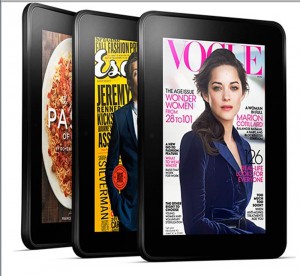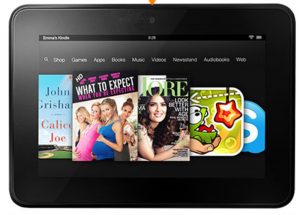
In 2011, for the first time, Amazon, the world’s biggest bookseller, sold more books in electronic format (Kindle) than in paper formats. How did this happen ? A number of things came together to make this possible – the increasing availability of, and acceptance and use of, smartphones and tablets has created a social culture that, more and more, wants to do things on the move. This happened at the same point that the technology advanced to the point where products such as the Kindle, or the apps for Kindle reading used on phones, became possible. Traditional books are great, but they are bulky. If you are already carrying a phone or Ipad, or you choose a dedicated Kindle reader, you can carry hundreds of books with you, in less than the space of one paperback.
The appeal was instantaneous and obvious. Concurrently, Amazon made it possible for anyone to self publish for Kindle, and have their book visible for sale on Amazon – so, over a three year period, the number of books available in electronic format has increased exponentially. Add to that a royalty structure and rules that ensure that most Kindle books are priced very cheaply, and everyone (but especially Amazon!) wins.
All this is fairly visible – what is less visible is how Kindle has changed the way in which we read, and what we read. When you had to carry a paperback around with you to read, this introduced certain constraints – you generally only carried one at a time, for a start, you paid a fair bit for it, so you wanted a sizeable read for your money, and if you carry a book, people always say “what’s that you are reading”, whilst curiously picking it up, or taking a long look at the cover. That last one rather tends to limit what you read in public, or take to work to read at lunchtime. Sometimes you just don’t want others to know what you are reading, whether its erotica (although 50 Shades of Grey has rather shifted the ‘acceptable’ boundaries on that one recently!), or your secret addiction to children’s horse stories, or trashy tell-all celebrity biographies.
But with Kindle, all that changed – now you have immense choice – carry a couple of hundred books if you want (they are cheap enough after all – at $2.99 each not $29.99 it’s a very different budget equation!) – change from one to another depending on your mood. Read your erotica, or feed your embarrassing secret addictions – no one can see what you are reading unless you show them, and you can get it closed to an innocent home screen with the push of one button, if someone is trying to be persistently nosy. Its quick and easy to pull out your phone, Kindle reader or your Ipad in all sorts of places, if you have a minute to spare – they are usually just in your pocket, or the top layer of your handbag. So many people actually read much much more now than they ever did before.
 But
what they read is different in structure and format, not just topic and
price. When you can read in short stolen moments, you are more likely
to want something short to read – no ongoing concentration needed, rip
through it fast on the bus for immediate satisfaction. When it only
costs $2.99 you don’t mind if its short – a 20 page story can be quite
satisfying for that sort of money. And that way, if it turns out that
you don’t like that author’s work, no great loss, no book to dispose of
either. And with Kindle, there are none of those “oh god, I left my
book at work” moments – your book is always with you – just use your
Kindle app on your phone, Ipad, or PC even if you left your Kindle
reader at work, or at home – the Amazon cloud will keep them all
synchronised for you, and even know where in the book you were up to!
But
what they read is different in structure and format, not just topic and
price. When you can read in short stolen moments, you are more likely
to want something short to read – no ongoing concentration needed, rip
through it fast on the bus for immediate satisfaction. When it only
costs $2.99 you don’t mind if its short – a 20 page story can be quite
satisfying for that sort of money. And that way, if it turns out that
you don’t like that author’s work, no great loss, no book to dispose of
either. And with Kindle, there are none of those “oh god, I left my
book at work” moments – your book is always with you – just use your
Kindle app on your phone, Ipad, or PC even if you left your Kindle
reader at work, or at home – the Amazon cloud will keep them all
synchronised for you, and even know where in the book you were up to! So
authors are publishing more and more ‘little books’ – the sort of thing
that traditional publishers would never have considered as a standalone
product – way too much cost and not enough return to be worthwhile.
And consumers are buying them, in their millions, because they are cheap
and easy to consume. This trend is likely to accelerate, in all topic
areas, making the electronic book market a multi, multi billion dollar
economy that did not even exist 6 years ago.
So
authors are publishing more and more ‘little books’ – the sort of thing
that traditional publishers would never have considered as a standalone
product – way too much cost and not enough return to be worthwhile.
And consumers are buying them, in their millions, because they are cheap
and easy to consume. This trend is likely to accelerate, in all topic
areas, making the electronic book market a multi, multi billion dollar
economy that did not even exist 6 years ago.What does this mean about the way in which people view books now ? More of us read, we read a much more varied selection of topics, we are less likely to read a great ‘epic novel’ (in fact, many just do not have that sort of concentration span these days), we spend just as much if not more on ‘books’ but get a lot more of them for our money, traditional bookshops are going out of business, and traditional publishers are struggling, and are trying to mandate prices for Kindle books which are similar to the pricing of their physical books (and Amazon tells you quite clearly on the book listing that the publisher set that price, not them! – their marketing people have got that one right…) and, lastly, millions of ordinary people, who would never have been able to get their work published in the past, have become published authors, and many have become outstanding bestsellers, with their works also made into film and TV.
No comments:
Post a Comment